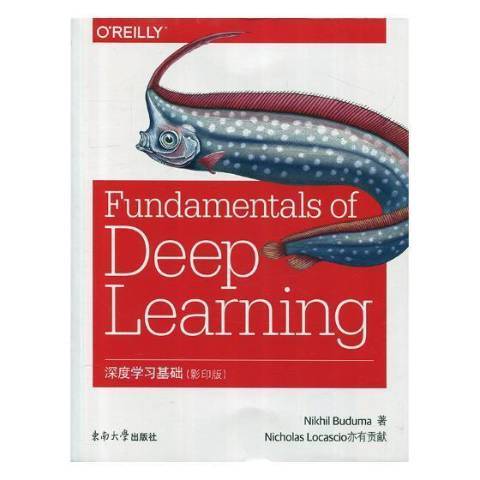《深度學習基礎》是2018年東南大學出版社出版的圖書。
基本介紹
- 中文名:深度學習基礎
- 作者:Nikhil Buduma
- 出版時間:2018年
- 出版社:東南大學出版社
- ISBN:9787564175177
- 類別:人工智慧
- 開本:16 開
- 裝幀:平裝-膠訂

《深度學習基礎》是2018年東南大學出版社出版的圖書。
《深度學習基礎》是2018年東南大學出版社出版的圖書。內容簡介 Google、微軟和Facebook等公司正在積極發展內部的深度學習團隊。對於我們而言,深度學習仍然是一門非常複雜和難以掌握的課題。如果你熟悉Python,並且具有微積分背景,以及對於機器...
《實用深度學習基礎》是2022年清華大學出版社出版的圖書,作者是屈丹、張文林、楊緒魁、牛銅、閆紅剛、邱澤宇、郝朝龍。內容簡介 本書根據深度學習技術發展速度快、理論性與實踐性強、套用廣泛等特點,結合教學、科研及套用需求,堅持“原理...
《深度學習基礎教程》首先介紹了深度學習的優勢和面臨的挑戰、深度學習採用深層架構的動機、學習深度學習需要的數學知識和硬體知識以及深度學習常用的軟體框架。然後對多層感知機、卷積神經網路(CNN)、受限玻耳茲曼機(RBM)、循環神經網路(...
《深度學習基礎與套用》是2021年北京理工大學出版社出版的圖書,作者是武玉偉、梁瑋、裴明濤。內容簡介 《深度學習基礎與套用》分四部分介紹深度學習算法模型及相關套用實例。分介紹在深度學習中的一些數學和機器學習的基礎知識。第二部分介紹...
《深度學習基礎與實踐》是2019年7月人民郵電出版社出版的圖書,作者是[美]喬希·帕特森、[美]亞當·吉布森。內容簡介 本書是由兩位技術出身的企業管理者編寫的深度學習普及書。本書的前四章提供了足夠的關於深度學習的理論知識,包括機器...
《深度學習基礎與工程實踐》是2021年電子工業出版社出版的圖書,作者是郭澤文。內容簡介 以工程實踐為主線,基於TensorFlow 2.0軟體框架詳細介紹了深度學習的工作原理和方法,並以實際代碼為例 內容提要 本書以工程實踐為主線,基於...
《深度學習入門:基於PyTorch和TensorFlow的理論與實現》是一本系統介紹深度學習基礎知識和理論原理的入門書籍。本書從神經網路的基本結構入手,詳細推導了前向傳播與反向傳播的數學公式和理論支持,詳細介紹了如今各種最佳化神經網路的梯度最佳化算法...
《深度學習理論與實戰:基礎篇》是2019年7月電子工業出版社出版的圖書,作者是李理。內容簡介 《深度學習理論與實戰:基礎篇》不僅包含人工智慧、機器學習及深度學習的基礎知識,如卷積神經網路、循環神經網路、生成對抗網路等,而且也囊括了...
《速通深度學習數學基礎》是電子工業出版社出版圖書,作者是盧菁 線性代數、微積分、機率論三條邏輯主線,以數學知識帶出深度學習知識 內容簡介 本書以理論結合實際的方式講解,使數學知識不再是冰冷的公式堆砌,而變成一個個真實的案例,...
第1章深度學習入門基礎 16 1.1 數學基礎 16 1.1.1 矩陣論基礎 17 【案例1-1】像指揮官一樣對矩陣進行“排兵布陣” 18 1.1.2 機率論基礎與重要結論 19 【應知應會】MATLAB中機率論基本命令 21 1.2 機器學習基礎 21 ...
《多模態深度學習技術基礎》是2023年9月1日清華大學出版社出版的圖書,作者:馮方向、王小 捷。內容簡介 內容上,本書力求系統地介紹基於深度學習的圖文多模態信息處理技術,側重介紹最通用、最基礎的技術,覆蓋了多模態表示、對齊、融合...
《深度學習入門與TensorFlow實踐》是2022年人民郵電出版社出版的圖書。內容簡介 本書首先介紹深度學習方面的數學知識與Python基礎知識,線性模型中的線性回歸模型和logistic模型;然後講述正向傳播算法、反向傳播算法及深度神經網路的完整訓練流程...
第5章 機器學習基礎 105 5.1 泛化:機器學習的目標 105 5.1.1 欠擬合與過擬合 105 5.1.2 深度學習泛化的本質 110 5.2 評估機器學習模型 115 5.2.1 訓練集、驗證集和測試集 115 5.2.2 超越基於常識的基準 118 5...
5.3.1 定義學習參數87 5.3.2 定義輸出節點88 5.3.3 定義反向傳播的結構88 5.4 訓練模型並輸出中間狀態參數89 5.5 測試模型90 5.6 保存模型91 5.7 讀取模型92 第2篇 深度學習基礎——神經網路 第6章 單個神經元96 6.1...
1.2 什麼是深度學習6 1.2.1 我們不分離——數據和算法6 1.2.2 深度學習基礎9 1.3 機器學習與深度學習10 1.3.1 機器學習的定義與種類10 1.3.2 機器學習的任務與方法13 1.3.3 深度學習的提出16 1...
畢業於北京大學物理學院,愛好機器學習和數據分析的核安全工程師,譯有《Python數據處理》《Python機器學習基礎教程》等。圖書目錄 第一部分 深度學習基礎 第1章 什麼是深度學習 2 1.1 人工智慧、機器學習與深度學習 2 1.1.1 ...
書中側重講述與深度學習基礎相關的網路模型和算法思想,以及圖神經網路的原理,且針對這些知識點給出在PyTorch框架上的實現代碼。本書適合想學習圖神經網路的技術人員、人工智慧從業人員閱讀,也適合作為大專院校相關專業的師生用書和培訓班的...
書中使用Python3,儘量不依賴外部庫或工具,從基本的數學知識出發,帶領讀者從零創建一個經典的深度學習網路,使讀者在此過程中逐步理解深度學習。書中不僅介紹了深度學習和神經網路的概念、特徵等基礎知識,對誤差反向傳播法、卷積神經網路...
全世界最為流行的深度學習框架有PaddlePaddle、Tensorflow、Caffe、Theano、MXNet、Torch和PyTorch。框架 PaddlePaddle 飛槳(PaddlePaddle)以百度多年的深度學習技術研究和業務套用為基礎,是中國首個自主研發、功能完備、開源開放的產業級深度學習...
本書共12章,主要內容包括深度學習基礎、深度學習的環境準備、深度學習的知識準備、神經網路基礎知識、使用Keras構建神經網路、神經網路的進一步最佳化、卷積神經網路、使用Keras構建卷積神經網路、卷積神經網路可視化、遷移學習、循環神經網路和使用...
第2篇 深度學習基礎——神經網路 第6章 單個神經元96 6.1 神經元的擬合原理96 6.2 激活函式——加入非線性因素,解決線性模型缺陷99 6.3 softmax算法——處理分類問題103 6.4 損失函式——用真實值與預測值的...
《深度學習入門之PyTorch》深度學習如今已經成為科技領域最炙手可熱的技術,在《深度學習入門之PyTorch》中,我們將幫助你入門深度學習。《深度學習入門之PyTorch》將從機器學習和深度學習的基礎理論入手,從零開始學習 PyTorch,了解 PyTorch ...
如何獲取學習資源 第1章 深度學習入門 1.1 Keras的介紹與安裝 13 1.2 學習深度學習需要具備的數學基礎知識 16 第2章 回歸算法 2.1 線性回歸 31 2.2 多元線性回歸 39 2.3 邏輯回歸 42 第3章 神經網路入門 3.1 簡單...
9.10 卷積網路的神經科學基礎 221 9.11 卷積網路與深度學習的歷史 226 第 10 章序列建模:循環和遞歸網路 227 10.1 展開計算圖 228 10.2 循環神經網路 230 10.2.1 導師驅動過程和輸出循環網路 232 10.2.2 計算...
《深度學習》對所有主要的深度學習方法和最新研究趨勢進行了深入探索。全書分為上下兩卷,五個部分。上卷包括兩個部分:第一部分是基礎算法,包括機器學習基礎算法、早期神經網路算法、深度學習的正則化方法和深度學習的最佳化方法;第二部分是...
當你完成這一切後,就為成為精通深度學習框架的專家做好了充分準備!《深度學習圖解》主要內容: 深度學習的基礎科學原理,自行設計和訓練神經網路,隱私保護的知識,包括聯邦學習,幫助你繼續深度學習之旅的建議。作者簡介 Andrew W. Trask...
